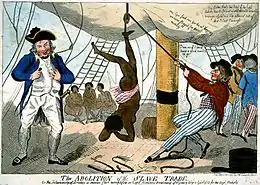John Kimber
John Kimber was the captain of a British slave ship who was tried for murder in 1792, after the abolitionist William Wilberforce accused him of torturing to death an enslaved teenage girl on the deck of his ship. Kimber was acquitted, but the trial gained much attention in the press. The case established that slave ships' crew could be tried for murder of slaves.

Publicity about the case contributed to growing opposition to the African slave trade, which the British parliament prohibited in its colonies by the Slave Trade Act 1807.
Killing
In 1791, John Kimber was the captain of Recovery, a slave ship of 189 tons (bm) from Bristol, England.[1] The Recovery travelled from Bristol to New Calabar in West Africa, where it collected approximately 300 slaves who were to be sold at Grenada in the Caribbean. The vessel left Africa on 1 September, and arrived at Grenada on 28 October, by which time 27 of the slaves had died.[2]
"Dancing the slaves" was a regular part of the routine of a slave ship on the Middle Passage; the captain and crew worked to ensure that slaves, who were confined to the extremely cramped and unhygienic conditions below decks, received at least a degree of fresh air and regular exercise on deck. Those who refused to take part in the dancing were flogged.[3]
On 2 April 1792, William Wilberforce made a speech to parliament at the end of a debate on the abolition of the slave trade.[4] He gave two examples of the atrocities associated with the slave trade, in order to appeal to the sympathy of fellow members of parliament. Firstly, he described an attack on Calabar by British slave ships, which bombarded the city in order to force its traders to lower the price of slaves.[5] The second example was the case of Captain Kimber, whom Wilberforce alleged had murdered a teenage slave girl on his ship who refused to dance for exercise. Kimber was said to have repeatedly lashed the girl and to have had her several times suspended by one leg and then dropped to the deck of the ship. Following this maltreatment, she died.
In his speech, Wilberforce emphasised the innocence of the girl. He downplayed the captain's claims (subsequently reported in the press) that she suffered from an unidentified preexisting medical condition causing lassitude and that she had gonorrhea.[6] Isaac Cruikshank's depiction of Kimber's assault on a "virjen," in his image published at the time, also emphasises her innocence in the face of the captain's aggression and moral corruption.[6]
On 7 April 1792, Kimber placed advertisements in several newspapers proclaiming his innocence.[6] The charges against Kimber were soon reported in the press, as were accounts of his trial beginning in June 1792. Such reports rapidly crossed the Atlantic and were published in ten American newspapers.[6]
Arrest and trial

Kimber was arrested in Bristol on 8 April, and taken to London the next day.[1] His trial at the Admiralty Sessions of the Old Bailey began on 7 June 1792, and was attended by many prominent public figures, including Horatio Nelson.[7][8]
The trial revealed little about Kimber's alleged crimes beyond what Wilberforce had said to parliament and was reported in the press.[9] The attention soon turned to the key witnesses testifying against Kimber. Thomas Dowling, the ship's surgeon, was revealed to have a vendetta against Kimber; another witness, Stephen Devereux, was a former mutineer.[9] Three witnesses attested to Kimber's good character, but no witness was called to affirm that Kimber had not ordered a slave girl to be tied up and flogged.[9]
Kimber was acquitted. In 1793 Dowling and Devereux were tried for perjury, with Dowling being found guilty.[7] Several accounts of the trial were published, which were supportive of Kimber to varying degrees.[10] Kimber pursued Wilberforce for damages after the trial, and continually loitered outside his house.[11] Wilberforce later noted that Kimber's acquittal had been one of the few instances in the abolition campaign that had brought him distress.[12]
Legal significance
In 1781, the crew of the slave ship Zong deliberately killed approximately 132 slaves by throwing them overboard, later claiming the entire ship and its cargo were endangered by lack of water. None of the crew was ever tried for murder, and the subsequent court cases established the legality of their act under specific circumstances of ensuring survival of the ship, crew and remaining slaves. The judge ruled against the insurers' paying for the loss of slaves because of new information revealed at the appeal hearing, which suggested the captain and crew were at fault for the shortage of water.[13]
Swaminathan says that neither the killings nor the 1783 court cases received much attention in the press or in parliament.[14] But nearly 300 Quakers were moved to send a petition to parliament against slavery in July 1783 because of this trial.[15] Walvin notes that by the late 1780s, the Zong case had become an important symbol of the abuses of the slave trade, having inspired anti-slavery writings by Thomas Clarkson, Ottobah Cugoano, James Ramsay and John Newton,[16][17] and stimulating the rapid growth of the abolitionist movement.[18]
It is significant that, only a decade after the Zong massacre, Kimber as captain of a slave ship was tried for murder in his maltreatment of a slave, and that the case received widespread attention in the newspapers.[19] As the Public Advertiser commented after Kimber's trial, the case had at least established that those who killed slaves could be tried for murder.[9]
Notes
- Marshall 1972, p. 207.
- Richardson 1996, p. 193.
- Maccotta 2007, pp. 132-3.
- Marshall 1972, p. 206.
- Swaminathan 2010, p. 487.
- Swaminathan 2010, p. 489.
- Swaminathan 2010, p. 490.
- Sugden 2011, p. 399.
- Swaminathan 2010, p. 493
- Swaminathan 2010, p. 494.
- Hague 2008, p. 210.
- Marshall 1972, p. 211.
- Krikler 2007, pp. 36–8.
- Swaminathan 2010, pp. 483, 496.
- Rupprecht, "A Very Uncommon Case" (2007), pp. 336–7.
- Lovejoy 2006, p. 337.
- Swaminathan 2010, pp. 483–4.
- Walvin 2011, pp. 176–9.
- Swaminathan 2010, pp. 483, 487.
References
- Hague, William (2008). William Wilberforce: The Life of the Great Anti-Slave Trade Campaigner. London: HarperCollins.
- Krikler, Jeremy (2007). "The Zong and the Lord Chief Justice". History Workshop Journal. 64 (1): 29–47. doi:10.1093/hwj/dbm035. S2CID 144154697.
- Lovejoy, P. E. (2006). "Autobiography and Memory: Gustavus Vassa, alias Olaudah Equiano, the African". Slavery & Abolition. 27 (3): 317–347. doi:10.1080/01440390601014302. S2CID 146143041.
- Maccotta, Carole (2007). "Dancing and exercise". In Toyin Falola and Amanda Warnock (ed.). Encyclopedia of the Middle Passage. Greenwood Publishing.
- Marshall, Peter (1972). "The Anti-Slave Trade Movement in Bristol". In McGrath, Patrick (ed.). Bristol in the Eighteenth Century. Newton Abbott: David & Charles. pp. 185–214.
- Richardson, David, ed. (1996). Bristol, Africa and the Eighteenth-century Slave Trade to America. 4: the final years. Bristol: Bristol Records Society. ISBN 9780901538178.
- Rupprecht, A. (2007). "Excessive Memories: Slavery, Insurance and Resistance". History Workshop Journal. 64 (1): 6–28. doi:10.1093/hwj/dbm033. S2CID 154933811.
- Sugden, John (2011). Nelson: A Dream of Glory. London: Random House.
- Swaminathan, S. (2010). "Reporting Atrocities: A Comparison of the Zong and the Trial of Captain John Kimber". Slavery & Abolition. 31 (4): 483–499. doi:10.1080/0144039X.2010.521336. S2CID 145650558.
- Walvin, James (2011). The Zong: A Massacre, the Law and the End of Slavery. New Haven & London: Yale University Press. ISBN 978-0-300-12555-9.
External links
- The trial of Captain John Kimber, for the murder of two female Negro slaves, on board the Recovery, African slave ship. London. 1792.
- British Museum information page about Cruikshank's image
- PortCities page on The Kimber Case